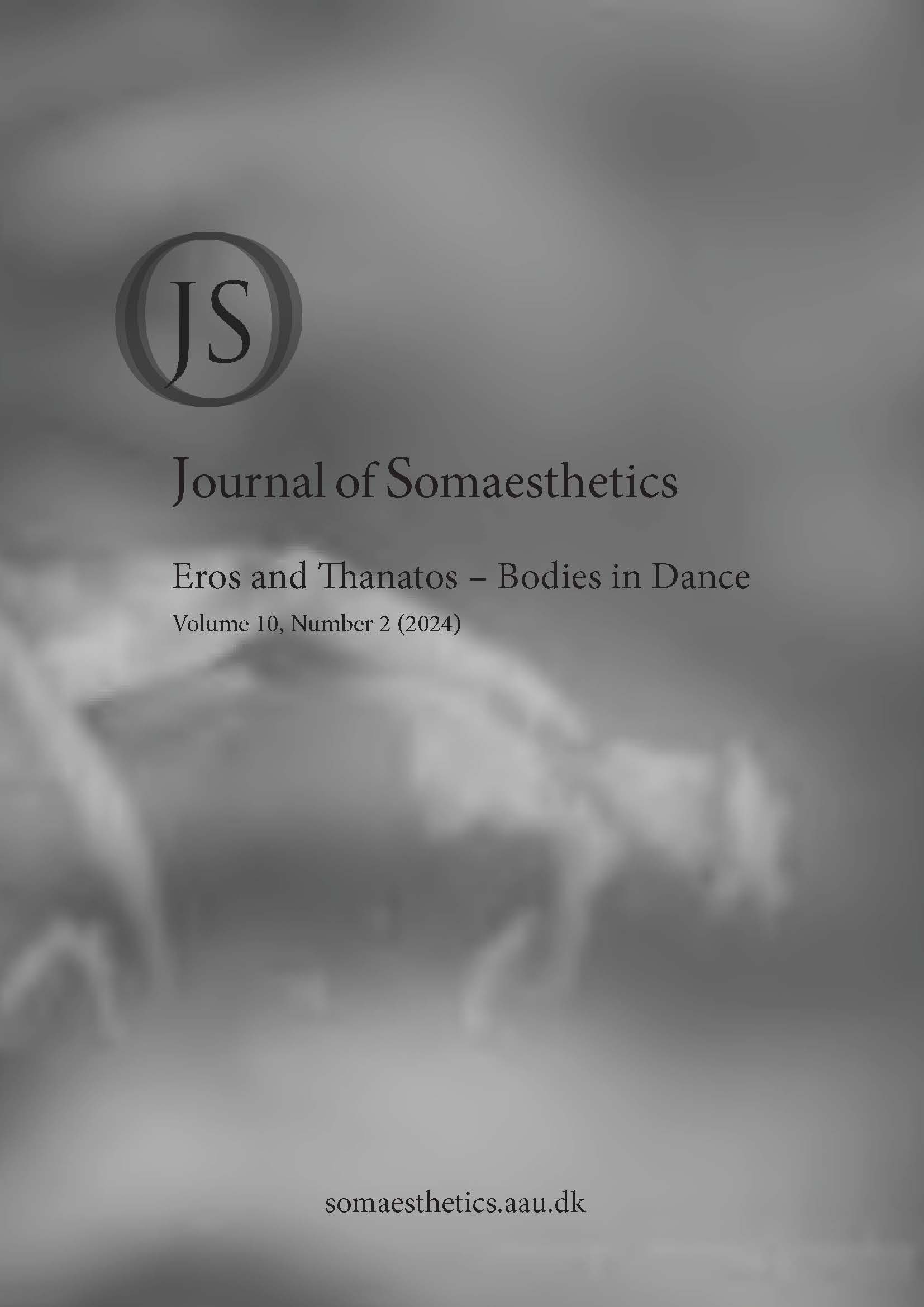The Eros and Thanatos Entwined: Somaesthetic Explorations in Kunqu Dance
DOI:
https://doi.org/10.54337/ojs.jos.v10i2.8601Abstract
This paper investigates somaesthetic principles in Kunqu opera, particularly through the classical work The Peony Pavilion, focusing on how dance movements convey the interplay of Eros and Thanatos. It delves into the spiritual influence of emotional commitment on Kunqu’s integrated system of poetry, music, and dance, and considers how traditional Chinese aesthetics may shape the mind-body relationship. This exploration seeks to contribute to the discourse on somaesthetics by suggesting that Kunqu dance offers nuanced insights into existential themes, thereby enriching our understanding of life and death within the arts.
References
ABai, X. (Director). (2007). The Peony Pavilion [Film]. Suzhou: Suzhou Kunqu Opera Theatre.
Bateson, G. (1979). Mind and nature: a necessary unity. Wildwood House
Baidu Baike. (2024 a). Qing情. [Online]. [Accessed 4 June 2024]. Available from: https://baike.baidu.com/item/情/34327?fr=ge_ala
Baidu Baike. (2024 b). Qing青. [Online]. [Accessed 4 June 2024]. Available from: https://baike.baidu.com/item/青/6923?fromModule=search-result_lemma-recommend
Baidu Baike. (2024 c). Sheng生. [Online]. [Accessed 4 June 2024]. Available from: https://baike.baidu.com/item/生/2654
Chang, K. I. S., & Owen, S. (Eds.). (2010). The Cambridge history of Chinese literature (Vol. 1). Cambridge University Press.
Cooper, D. E. (2003). World philosophies : an historical introduction (2nd ed.). Blackwell.
Descartes, R. (2004) [1637]. A Discourse on Method: Meditations and Principles. Translated by Veitch, John. London: Orion Publishing Group.
Dong, P. (2020). Zhuxi: Lixue de Benzhi Shishenme朱熹 [Zhuxi: What is the Philosophical Nature of the neo-confucianism?]. [Sanlian Zhongdu]. Shanghai Sanlian Publishing House. [Accessed 1 June 2024]
Editorial Committee of the KCCTC. 2015. Key Concepts in Chinese Thought and Culture I. Beijing: Foreign Language Teaching and Research Press.
emotion | Etymology of emotion by etymonline. (n.d.). Retrieved from https://www.etymonline.com/word/emotion
Fang, Y. (2015). Zhuangzi庄子 [Zhuangzi]. 2nd ed. Beijing: Zhong Hua Book Company.
Feng, Y. (2015). A Short History of Chinese Philosophy. Foreign Language Teaching and Research Press.
Freud, S., & Freud, S. (1961). Beyond the Pleasure Principle. Translated and newly edited by James Strachey. Hogarth Press & Institute of Psycho-Analysis.
Hu, C. (2012). Zhongguo Xiqu Shiwujiang中国戏曲十五讲 [Fifteen Talks about Chinese Xiqu]. Beijing: Beijing Normal University Press.
Huang, S. (2024). Qianpai Yunshou钱派云手 [Qian Style Cloud Hand]. [Online]. [Accessed 4 June 2024]. Available from: https://www.bilibili.com/
Jin, H. (2020). Xiqu Wudao Shuyu Cidian戏曲舞蹈术语词典[Dictionary of Xiqu Dance Terms]. Shanghai: Shanghai Music Publishing House.
Kandinsky, W., & Sadleir, M. (1977). Concerning the spiritual in art. Dover Publications [etc.].
Mao, H. (2018). Maoshichuan Jian毛詩傳箋 [The Anotation of Mao's Poetry]. Zheng Xuan, Lu Deming and Kong Xiangjun. eds. Beijing: Zhong Hua Book Company
Mao, R. (2018). Zhuangzi and the Ming-dynasty Chinese Opera (doctoral dissertation). Shaanxi Normal University, Xi’an, China.
Niu, B., Zhang, X., Fu, X., Zhu, F., Shen, S. et al.1996. Zhongguo Kunqu Yishu中国昆曲艺术 [The Art of Chinese Kunqu]. Beijing: Beijing Yanshan Press.
Olsen, S. A. (2009). The golden section: nature’s greatest secret ([New ed.].). Wooden Books.
Plato. et al. (2008) Symposium. Cambridge: Cambridge University Press.
Qi, R. (2005). Qi Rushan Huiyilu齐如山回忆录 [Memoirs of Qi Rushan]. Shenyang: LiaoNing Education Press.
Shusterman, R. (2008). Body consciousness: a philosophy of mindfulness and somaesthetics. Cambridge University Press.
Su, Z. (1980). Xiqu Wdao Meixue Lilun Ziliao戏曲舞蹈美学资料 [Xiqu Dance Aesthetic Theory Materials]. Wuhan: Wuhan Branch of China Dancers Association.
Tang, X. (2016). Mudan Ting牡丹亭 [The Peony Pavilion]. Lin Wenrui. ed. Beijing: Zhong Hua Book Company.
Waley, A., Chen, G., & Fu, H. (1999). Laozi. Hunan People's Publishing House & Foreign Languages Press.
Wang, B. (1980). Wang Bi Ji Jiaoshi王弼集校釋 [Annotations on the collation of Wang Bi's collected works]. Lou Yulie. ed. Beijing: Zhong Hua Book Company.
Xu, F. (2019). Zhongguo Yishu Jingshen中国艺术精神 [Spirit of Chinese Art]. Liaoning People's Publishing House.
Xu, Y. (2021). Xu Yuanchong Yingyi Chuantong Wenhua Jingdian许渊冲英译传统文化经典 [Xu Yuanchong's English translation of traditional cultural classics]. China Translation& Publishing house.
Yang, F. (2002). Liyuan Yanjue Jiyao梨园谚诀辑要 [A collection of proverbs from Chinese Theatre]. Beijing: China Theatre Press.
Ye, L. (1985). Zhongguo Meixueshi Dagang中国美学史大纲 [The Outline of Chinese Aesthetic History]. Shanghai: Shanghai People's Publishing House.
Yang, L. (2024). Beida Yang Lihua Jiaoshou Jiang Zhuangzi Zhexue北大杨立华教授讲庄子哲学 [Professor Yang Lihua of Peking University Lectures on Zhuangzi Philosophy]. [Online]. [Accessed 6 June 2024]. Available from: www.bilibili.com/cheese/play/ep14661
Yin, F. (2018). Zhongguo Gudai Yinyue Yu Wudao中国古代音乐与舞蹈 [Ancient Chinese Music and Dance]. Bejing: Beijing Publishing House.
Yu, Q. (2004). Disheng Hechu笛声何处 [Where Is the Fluting]. Guwuxuan Publishing House.
Zhao, M. (2019). Suyuan “Cun Tianli, Mie Renyu” 溯源“存天理,灭人欲” [The origin of "Cherishing the heavenly principle, Overcoming human desires"] . Test and Research (07), 166.
Zhou, C., & Luo, D. (1988). Kunju Shengya Liushinian昆曲生涯六十年 [Sixty-years of Performing Kun Opera]. Shanghai Literature and Art Publishing House.
Zheng, X. (2021). Liji Zhu礼记注 [Notes on the Book of Rites]. Beijing: Zhonghua Book Company.
Zou, H. (1985). Shenduanpu Koujue Lun 身段谱口诀论 [Theory of Shenduan Mnemonic notes]. Lanzhou: Gansu People's Publishing House.
Downloads
Published
Issue
Section
License
Copyright (c) 2025 Xueting Luo

This work is licensed under a Creative Commons Attribution-NonCommercial-NoDerivatives 4.0 International License.
Articles published in The Journal of Somaesthetics are following the license Creative Commons Attribution-NonCommercial-NoDerivs 4.0 Unported (CC BY-NC-ND 4.0). Authors retain copyright and grant the journal right of first publication with the work simultaneously licensed under a Creative Commons Attribution License: Attribution - NonCommercial - NoDerivs (by-nc-nd). Further information about Creative Commons
If excerpts, tables, figures, charts, artwork or photographs from other copyrighted works are included in an article, it is the author’s responsibility to obtain written permission from the copyright owners and credit the source’s in the article and citation list.


